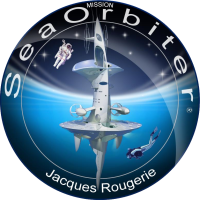 Official Logo of the SeaOrbiter Project | |
| General characteristics | |
|---|---|
| Type | Research/Semi-submersible |
| Height | 51 m (167 ft) |
The SeaOrbiter, also known as Sea Orbiter (two words), is a proposed oceangoing research vessel based on the ideas of French architect and oceanographer Jacques Rougerie. Construction was due to start in 2014 but by May 2015, only the Eye of SeaOrbiter has been completed, [1] and as of 2024, there is no news of any other construction.
Contents
The SeaOrbiter is planned to allow scientists and others a residential yet mobile research station positioned under the oceans' surface, with laboratories, workshops, living quarters and a pressurized deck to support divers and submarines. [2]
SeaOrbiter is a project of the "Floating oceanographic laboratory" organisation. It is headed by Jacques Rougerie, oceanographer Jacques Piccard and astronaut Jean-Loup Chrétien. In 2012 the cost was estimated to be around US$52.7 million. [3]